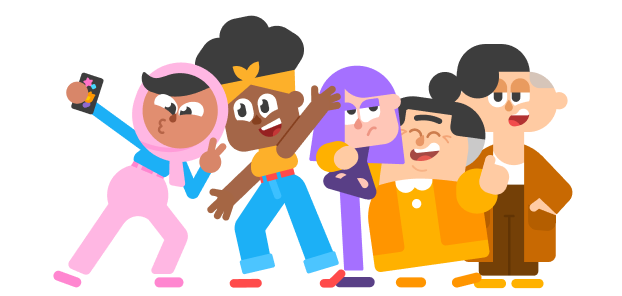You probably can’t imagine a lesson without Duolingo’s cast of characters, but they’re pretty new to the Duolingo universe! In a short time, though, they’ve become more than just characters–they’re friends and cheerleaders for learners around the world. But they didn’t just come out of nowhere!
Enter: Emily Chiu. Emily is a Creative Producer at Duolingo and has worked here for just over three years. She works with a lot of different content in the app, including Stories, and is one of the people who helped develop our World Characters! We asked Emily to talk a little bit more about the origin stories behind our favorite Duolingo women: Lily, Zari, Bea, Lin, and Lucy.

How did you go about naming these characters?
This was actually a lot more challenging than you might imagine. We wanted to keep the names pretty similar across languages for consistency. For example, if you’re posting about a character on social media (“I’m such a Bea!”) you wouldn’t want it to be Bea in one language and Beth in another; it would be hard to create the connection that it’s the same character.
Because of that, we had to do a lot of cross-referencing to make sure the names didn’t have weird meanings in any language while keeping them fairly close to the names we’d chosen in English.
Of course, we also wanted to make sure the names fit each character’s personality and were relatively easy to pronounce for all of our learners! There were a few other special considerations, like Lin and Lucy sharing an “L” name—we wanted to signify to learners that they were closely connected.
Which woman do you most enjoy writing for/building narrative for?
I love working on Bea. She is honestly an easy character to write for because she wants things and she’s very ambitious. Any protagonist that wants things is easy to write for, because they experience a lot of struggles and they’re always putting themselves out there.
What was the process for developing the group dynamic, from distinct personalities to varying ages?
It was really important for us to have different ages, ethnicities, and personalities so that learners all over the world could relate to at least one character. In terms of group dynamics, there’s a lot of natural drama generated from opposites attracting. You may notice a lot of our character pairings are like that! Zari is super outgoing, while her best friend Lily is super introverted; Lin is really laid-back, but Bea is quite neurotic. These make for fun storytelling opportunities!
Lin and Lucy are one pair of related characters–why was it important to depict that grandmother-granddaughter relationship?
In American culture, depictions of nuclear families are more prominent. But in other cultures, grandparents play a large role in raising children–especially in Asian cultures, I know a lot of people who were raised by grandparents. I thought it was an important idea to depict in our world. Plus, there’s the language element: learners need opportunities to study family and relationship vocabulary!
You mentioned diversity–how did you think about representation when creating these women, while also writing against stereotypes?
We thought a lot about how to subvert stereotypes, but the most important thing was keeping the characters real. To do that, we pulled in a lot of inspiration from our own lives – friends, sisters, moms – who reminded us of our characters. If you know even one person who shares Lily’s self-protective sarcasm, then I hope she feels real to you. (Personally, I was a total Lily in high school – her apathy and reticence – mixed with Zari’s need to be a straight-A student.) The more specific you can be about the traits that make us who we are, the more realistic and meaningful the representation will be.
Are any of the characters inspired by a woman in your life?
The dynamic between Lin and Bea is somewhat inspired by me and my childhood best friend. Growing up, I was very type-A, like Zari, and my best friend was very much a Lin. I put a lot of effort into everything while she winged it. And somehow it would always work out better for her… which was endlessly frustrating to me! But yes, my BFF was definitely a little bit of a Lin. Funnily enough, as we grew up, we both started gravitating towards the middle of the Bea-Lin spectrum.
Can you give us a fun fact about each of the characters? Starting with…
Lin: She loves sandwiches.
Bea: She has never enjoyed a massage.
Lily: She only listens to bands you’ve never heard of.
Zari: She’s probably in 10 clubs at school and president of 8 of them.
Lucy: Lucy… has a mysterious past.
Can you say more about that? I’m sworn to secrecy.



